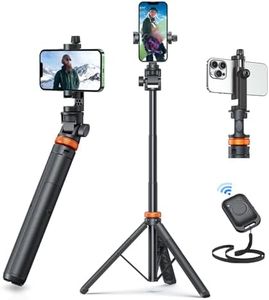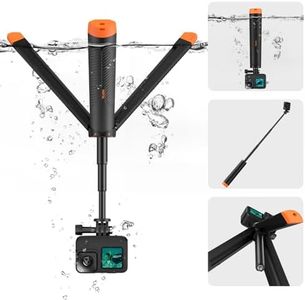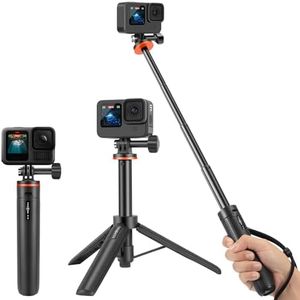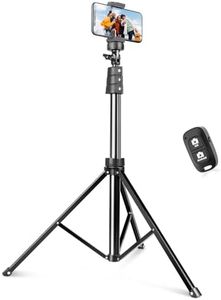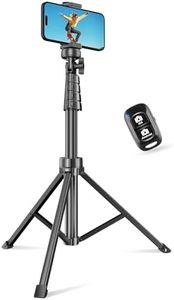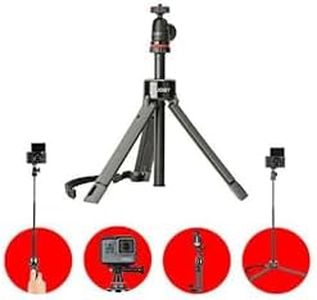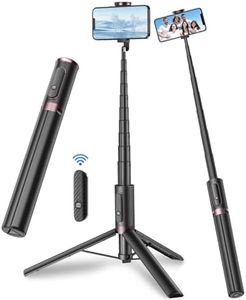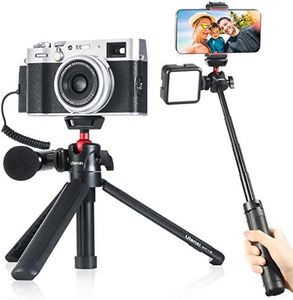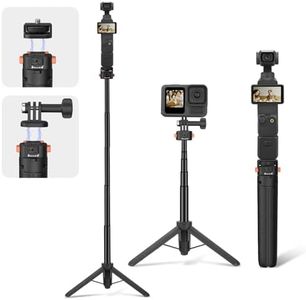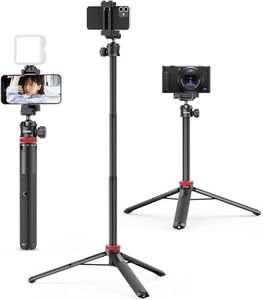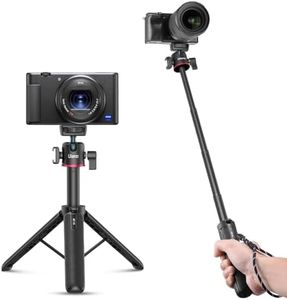We Use CookiesWe use cookies to enhance the security, performance,
functionality and for analytical and promotional activities. By continuing to browse this site you
are agreeing to our privacy policy
10 Best Tripod Selfie Sticks
From leading brands and best sellers available on the web.Buying Guide for the Best Tripod Selfie Sticks
When buying a tripod-selfie stick, it’s important to balance portability, stability, and convenience based on what you’ll use it for. Tripod-selfie sticks are hybrids designed for people who want to take photos and videos hands-free (like group shots or vlogging), but also want the ease of a selfie stick for spontaneous moments. The best way to pick the right one for you is to think about how often you’ll carry it around, what kind of phone or camera you plan to attach, and the environments in which you’ll be using it (like traveling, home, outdoors, or events).Maximum HeightMaximum height refers to how tall the tripod or selfie stick can get when fully extended. It’s important because a higher reach can help you fit more people in a group photo or capture different perspectives. Compact models might extend only around 20–30 inches, which is enough for most selfie or close-up shots but limited for group or scenic pictures. Medium-range tripods go up to about 40–50 inches and are a good all-rounder for both selfies and basic stable shots. Larger models over 50 inches provide more flexibility, almost matching regular tripod heights but can be bulkier. If you often shoot solo or with friends outdoors, a taller model is useful. If you mainly take selfies or travel a lot, a smaller, lighter version will be easier to carry.
Weight and PortabilityWeight and portability are about how easy it is to carry the stick around. A lighter tripod-selfie stick is great for travel or everyday use, as it won’t weigh down your bag. Heavier ones may be sturdier, but they can become inconvenient to carry. Some fold down very small, which is perfect if you need something that fits in your pocket or purse. Think about where you’ll be bringing it—travelers and commuters often prefer the lightest, most compact options, while at-home creators might be happier with a heftier model that offers more stability.
Build MaterialThe build material—often aluminum, plastic, or a mix—sets how strong, stable, and durable the stick is. Plastic is light and cheap but can be less stable, especially when fully extended or holding heavier phones. Aluminum is stronger and more stable, making it better for outdoor use or attaching bigger devices, but can be heavier. There are also versions with reinforced plastic or carbon fiber for examples that balance weight and strength. If you care about durability and expect to use the stick a lot, go for something sturdier. If you just need occasional use and light weight, plastic is fine.
Phone/Device Holder CompatibilityThis feature determines what kind of smartphone, camera, or device the tripod-selfie stick can hold. Some are adjustable with spring or screw mounts to fit various phone sizes, while others are fixed and might not fit larger devices. If you use thick phone cases or plan to switch phones/cameras, check the holder’s maximum width. Universal or adjustable holders are the safest bet for flexibility. Choosing one that fits your current and possible future devices saves headaches.
Bluetooth Remote ControlMany tripod-selfie sticks include a Bluetooth remote for hands-free shooting. This makes it easy to take pictures without physically pressing your phone’s button—perfect for group shots, solo poses, or videos. Some remotes attach to the stick so you won’t lose them, while others are separate. Reliable connectivity and battery life also matter. If you often want to take photos from a distance or without timers, prioritize a model with a solid remote. Occasional users may not need this and can stick to manual shutter options.
Tripod Stability and Foot DesignTripod stability is how well the stick stands on its own without tipping over. Some have three small feet, others broad, non-slip bases. Wide or rubberized feet help on uneven or slippery surfaces. Stability becomes essential if you plan to use it outdoors, for video calls, or to support heavier phones. If you’ll use the tripod on smooth or delicate surfaces, look for non-slip feet to prevent slips and scratches. For quick selfies, this may be less crucial.
